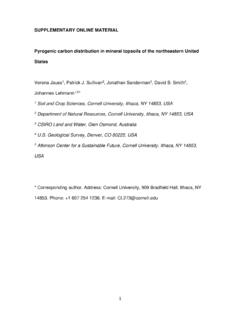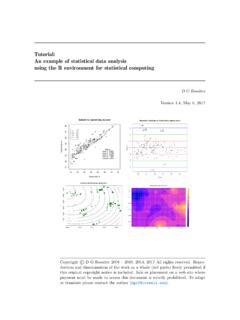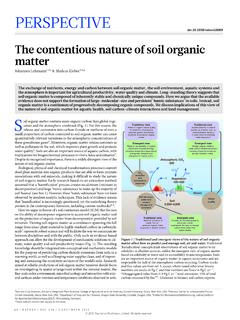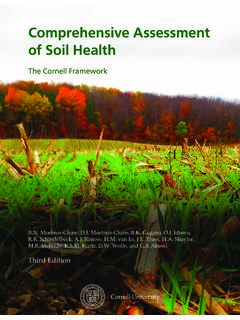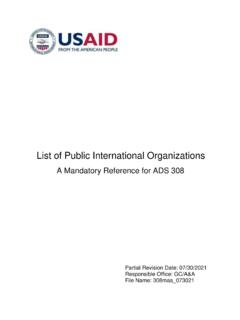Transcription of Chapter 7 Nutrient Leaching - Cornell University
1 Chapter 7 Nutrient LeachingJ. LEHMANN1 ANDG. SCHROTH21 College of Agriculture and Life Sciences, Department of Crop andSoil Sciences, Cornell University , 909 Bradfield Hall, Ithaca, NY14853, USA; 2 Biological Dynamics of Forest Fragments Project,National Institute for Research in the Amazon (INPA), CP 478,69011 970 Manaus, AM, SynopsisNutrient Leaching is the downward movement of dissolved nutrients in thesoil profile with percolating water. Nutrients that are leached below therooting zone of the vegetation are at least temporarily lost from the system,although they may be recycled if roots grow deeper.
2 Leached nutrientsmay contribute to groundwater contamination in regions with intensiveagriculture. Nitrate Leaching is also a significant source of soil humid climates, some Nutrient Leaching occurs even under naturalvegetation, but agricultural activities can greatly increase Leaching losses(Havlin et al., 1999). Soil and climatic factors that influence Nutrient leachingIn general, water transport below the rooting zone requires that the soilwater content exceeds field capacity and the water balance is positive,which means that water inputs with rainfall (and irrigation) exceedevapotranspiration.
3 Therefore, Nutrient losses through Leaching aregenerally higher in humid than in dry climates (Havlin et al., 1999). Incertain soils, however, water can infiltrate into the subsoil throughcontinuous vertical macropores when the bulk soil is dry. This is especiallyimportant in cracking clay soils (Vertisols) at the onset of the rainy season(Smaling and Bouma, 1992). Macropores are also created by faunal activityand root growth. They only conduct water under conditions of heavy151 CAB , Crops and Soil Fertility (eds G. Schroth and Sinclair)rainfall or irrigation, under other conditions they are filled with or bypass flow may increase Nutrient Leaching following thesurface application of fertilizers, because a solution with high nutrientconcentration then infiltrates rapidly into the soil with little contact withthe soil matrix.
4 On the other hand, macropore flow may also protectnutrients present in smaller soil pores from being leached by rapidlychannelling away surplus water (Cameron and Haynes, 1986; vanNoordwijk et al., 1991b). Soils with high water infiltration rates and low Nutrient retentioncapacity, such as sandy soils and well-structured ferrallitic soils with low-activity clays and low organic matter contents, are particularly conduciveto Nutrient Leaching (von Uexk ll, 1986). Some nutrients are easily leachedfrom organic soils (see below). Subsoil acidity also tends to increase nutrientleaching by restricting the rooting depth of sensitive plants (see ).
5 In the subsoil of many tropical soils the mobility of nitrate and otheranions decreases because of increasingly positive net charge and, therefore,anion retention by soil minerals, and this increases the probability thatthese ions are eventually taken up by deep-rooting plants (see Box onp. 171). It is, therefore, important to distinguish between Nutrient leachingwithin the soil profile, from the topsoil into the subsoil, leading totemporary Nutrient loss, and Leaching beyond the rooting zone of deep-rooting plants, into the groundwater, leading to permanent Nutrient loss. Susceptibility of different nutrients to leachingThe Leaching risk for a Nutrient increases with its mobility in the Nutrient anions, nitrate is particularly easily leached because itshows negligible interaction with the negatively charged matrix of mosttopsoils and is, therefore, very mobile in the soil (see Section ).
6 Nitrification rates are variable in tropical soils, but can be sufficiently highto make nitrate the dominating form of mineral nitrogen even in acid soils(Robertson, 1989; Schroth et al., 1999a). As a consequence, Leaching maycontribute significantly to negative nitrogen balances of agriculturalsystems (Smaling et al., 1993). In seasonal climates, nitrate is alsoparticularly exposed to Leaching because a mineralization flush of organicnitrogen that causes release of large quantities of nitrate in the topsoil oftenoccurs when dry soil is rewetted at the onset of the rainy season, at a timewhen crops have not yet been sown or are still small (Birch, 1960).
7 A mineralization flush at rewetting of dry soil has also been reportedfor sulphur (Havlin et al., 1999). Sulphate is also readily leached fromsurface soils, the losses being highest in soils dominated by monovalentcations (potassium, sodium) and lowest in soils with high amounts of152J. Lehmann and G. Schrothaluminium (Havlin et al., 1999) (see Section ). Dissolved organic sulphurcontributed between 18 and 86% of total dissolved sulphur at 2 m depthin an agroforestry system in central Amazonia (J. Lehmann, unpublisheddata). In contrast to nitrate and sulphate, phosphate is immobile in most soilsbecause of precipitation and adsorption to mineral surfaces, and leachingis therefore negligible, except in certain very sandy and organic soils (Wild,1988) (see Section ).
8 Dissolved organic phosphorus forms are moremobile in soil than phosphate (Havlin et al., 1999). Phosphorus may alsobe lost if surface soil particles are eroded in runoff (see Section ). The percolating soil solution that carries nutrients down the soil profileis necessarily electrically neutral; therefore, anions are leached togetherwith equivalent amounts of cations. In most soils, the cations most likelyto be leached are calcium and magnesium. In West African savanna soils,close relationships between the combined concentration of Ca and Mg andthat of nitrate in the soil solution below the crop rooting zone have beenreported, pointing to the role of fluxes of nitrate, and to a lesser extentchloride, as factors controlling calcium and magnesium Leaching in thesesoils (Pieri, 1989).
9 In sandy soils, considerable amounts of magnesium canbe leached after applications of potassium chloride or potassium sulphatefertilizers (Havlin et al., 1999). Potassium is usually leached in much smallerquantities than calcium and magnesium even when applied as fertilizerand was not related to nitrate fluxes in the aforementioned studies in WestAfrica (Pieri, 1989). However, significant potassium Leaching may occur insandy and organic soils and in high-rainfall areas (Malavolta, 1985; Havlinet al., 1999). Among the micronutrients, manganese and boron aresusceptible to Leaching in certain soils (Havlin et al.)
10 , 1999). Management practices that reduce Nutrient leachingA number of agricultural practices reduce Nutrient losses through leachingby increasing the synchrony and synlocation of Nutrient uptake by thevegetation with Nutrient supply from soil, mineral fertilizers and organicmaterials (see Section ). These include: early sowing of crops at the onset of the rainy season in savannaclimates to make use of the mineralization flush of nitrogen uponrewetting of the soil (Myers et al., 1994); rapid installation of a vegetation cover after forest or fallow clearingto avoid Nutrient losses from bare soil (Webster and Wilson, 1980; vonUexk ll, 1986); applying fertilizers (especially nitrogen) in several small applicationsduring the cropping season rather than all at once; and Nutrient Leaching153 placing fertilizer at the zone of maximum root activity of tree crops(IAEA, 1975; Havlin et al.

